A little over a year into its mandate, a City of Abbotsford program is looking at how it can utilize the information it’s collecting to more strategically fight homelessness.
In an update to the City of Abbotsford’s homelessness action advisory committee, the co-ordinated intake and referral (CIR) program said it has received 387 referrals, offering the city a more complete picture of the homeless and at-risk population than tools like homeless counts.
The CIR program is intended to assist homeless and at-risk individuals in connecting with services and housing and, through that program, “by default, there is a creation of an aggregate list of people who (are) homeless and may or may not be known by name.”
RELATED: Homeless referral program launched after years of work
In March 2017, a homeless count conducted in Abbotsford found 271 individuals experiencing homelessness. But homeless counts come with limitations, only being snapshots of a point in time conducted over a few days.
By contrast, the list generated by CIR referrals offers a picture of homelessness in motion, with information collected since September 2017, as well as a glance at the margins – those at risk of homelessness are also referred to the program.
CIR referrals also offer a glance at those who have gotten into homes or accessed other services. According to the update, October saw an increase in referrals, with 50 participants currently engaged. Of those 50 participants, 12 are housed and 27 and are “imminently ready.”
RELATED: Homeless numbers spike 79 per cent in Abbotsford
The CIR list could also offer some more detailed insights to assist with homelessness mitigation efforts – the committee update notes the “potential for creating another list referred to as a by-name priority list.”
That second list would be able to identify individuals who are experiencing “chronic” homelessness – those who have been homeless for the long term and who have “complex care needs and as a result are (the) most vulnerable.”
“The purpose of a by-name priority list is to filter the most vulnerable to the top of the list for housing placement that provides housing and supports.
“The by-name list identifies individuals who (are) imminently ready to move into housing,” the report reads.
RELATED: Program to help homeless seeing success, Abbotsford mayor says
Those who are “imminently ready” are interested in the supports, and have completed paperwork for housing, such as applications and income paperwork.
“The adoption of a by-name priority list is an accepted practice for communities who want to end homelessness in their communities. This list is managed and maintained through a collaborative approach of service providers and community partners,” the report reads.
The report also points to the 20,000 Homes Campaign, an initiative by the Canadian Observatory on Homelessness focused on ending homelessness by asking communities to set targets and supports for those targets. Among those supports are a by-name list, toolkits and co-ordinated use of data such as that of the CIR program.
“This campaign could possibly be a next step for our community, building on the developments from the CIR Pilot Project and the systems work for Abbotsford Homelessness Prevention and Response,” the report says. “There may be opportunities to join the campaign in 2019.”
